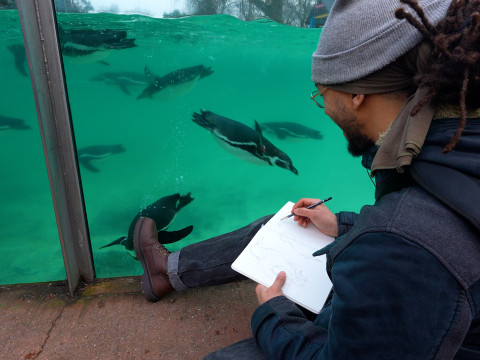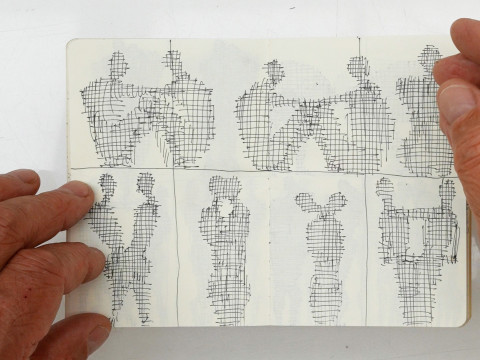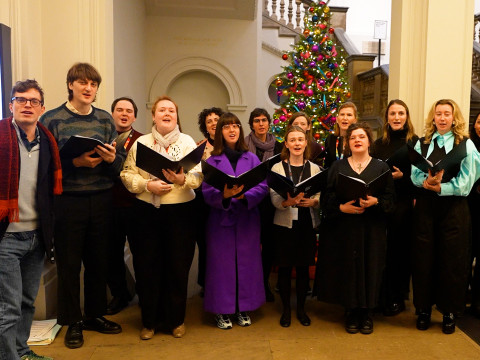
Postcards from the edge of the Earth: Emma Stibbon’s polar art
By Nancy Campbell
Published on 18 June 2015
A new exhibition showcases the Academician’s artistic response to her Arctic and Antarctic journeys.
Emma Stibbon RA has recorded some of the world’s most transient landscapes, from the decaying architecture of East Berlin to Iceland’s volcanic terrain.
Recently the artist has made intrepid voyages to extreme latitudes to observe disappearing glacial forms. Stibbon was sailing down the Antarctic Peninsula aboard HMS Protector (on an artist placement with Scott Polar Research Institute and the Royal Navy) when she received the news of her election as an Academician in March 2013. Later the same year, she embarked on a three-week journey up the west coast of Svalbard with the arts organisation The Arctic Circle.
Her austere, monochrome prints and drawings documenting icebergs and ice sheets from both ends of the earth are now on show in the exhibition Ice Limit at The Polar Museum in Cambridge, home to the archives of many polar expeditions as well as contemporary glaciological research.

Lead, 2014

Sea Ice, 2014

Night Navigation, 2014

Lead II , 2014
Stibbon is well read on the climate science that underlies her work. “We are witnessing a dramatic melt within our own lifetime,” she asserts. “As an artist I am moved to somehow respond to this. For me the challenge is to represent the fragility of the subject through the composition and material construction of the image.”
The earliest polar expeditions often included an artist to record their discoveries, but today’s scientists are more likely to rely on remote recording – for example, via satellite – to capture data. In contrast to the sophisticated digital technologies employed by personnel on HMS Protector, Stibbon used brush and ink to draw swiftly from observation. She believes that the human, tactile response still has an important role in science communication.
The act of drawing has an “almost magical” quality for Stibbon. In works such as Sea Ice (2014, pictured above) she has introduced shimmering aluminium and graphite powder to evoke an otherworldly landscape. In the diptych Corrie (below), subtle washes of black ink evoke the drama of the terrain appearing through shifting cloud cover. These friable materials also reflect the elusive nature of her subject.

“The polar regions are remote and disorientating landscapes where scale and distance confound the eye,” says Stibbon. “Passing through this strange, ethereal light certainly felt like one was travelling into an internal world. I wanted the work to reflect a feeling of reverie or introspection.” To the Academician, glaciers and icebergs are not only dynamic geographical features but also places that haunt the imagination. Her work sits firmly within the European Romantic tradition, and draws on the concept of the Sublime, identified by the 18th-century philosopher Edmund Burke as a psychological state induced by immense and “awful” places.
Stibbon’s works have always challenged viewers to reflect on their relationship to place, and the passage of time. “As a human species, we want to believe that our surroundings are immutable and resilient,” she says. But despite their monumental nature, the works in Ice Limit challenge such complacency, revealing instead a vulnerable environment, caught on the cusp of change.
Emma Stibbon RA
The Royal Academician discusses her work in Antarctica.
Ice Limit is at The Polar Museum in Cambridge from 11 June until 5 September 2015.
Nancy Campbell is an artist and writer, and the editor of Printmaking Today magazine. She will be artist in residence at Ilulissat Kunstmuseum, Greenland, in August 2015.
Related articles

Video: drawing penguins at London Zoo
3 February 2025

My sketchbook: sculpture drawings by Antony Gormley RA
13 January 2025

Video: Merry Christmas from the Burlington House choir
18 December 2024